Decimals/Fractions Study Guide
Understanding Decimals
A decimal is a way of writing a part of a whole number. It is based on powers of 10. For example, in the decimal 0.75, the 7 is in the tenths place and the 5 is in the hundredths place.
Converting Decimals to Fractions
To convert a decimal to a fraction, follow these steps:
- Write the digits of the decimal as the numerator.
- Count the number of decimal places and write 10, 100, 1000, etc. as the denominator, depending on the number of decimal places.
- Simplify the fraction if possible.
Understanding Fractions
A fraction represents a part of a whole. It consists of a numerator (the top number) and a denominator (the bottom number). For example, in the fraction 3/4, the 3 is the numerator and the 4 is the denominator.
Converting Fractions to Decimals
To convert a fraction to a decimal, divide the numerator by the denominator. The result is the decimal equivalent of the fraction.
Practice Problems
1. Convert 0.6 to a fraction.
Answer: 0.6 = 6/10 = 3/5
2. Convert 5/8 to a decimal.
Answer: 5 ÷ 8 = 0.625
. Create and Print your own Math Worksheetswith Math Worksheet Generator
◂Math Worksheets and Study Guides Fourth Grade. Decimals/Fractions
Study Guide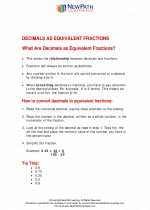 Decimals/Fractions
Decimals/Fractions  Activity Lesson
Activity Lesson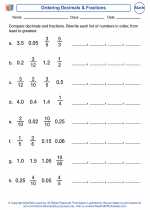 Ordering Decimals & Fractions
Ordering Decimals & Fractions  Activity Lesson
Activity Lesson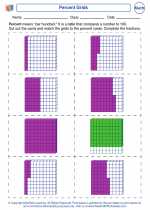 Percent Grids
Percent Grids  Activity Lesson
Activity Lesson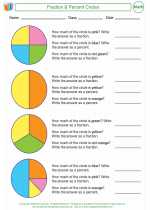 Fraction & Percent Circles
Fraction & Percent Circles  Worksheet/Answer key
Worksheet/Answer key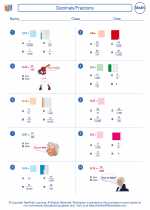 Decimals/Fractions
Decimals/Fractions  Worksheet/Answer key
Worksheet/Answer key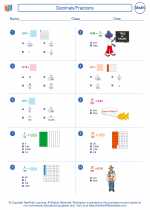 Decimals/Fractions
Decimals/Fractions  Worksheet/Answer key
Worksheet/Answer key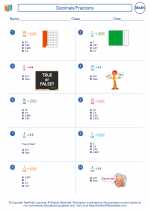 Decimals/Fractions
Decimals/Fractions  Worksheet/Answer key
Worksheet/Answer key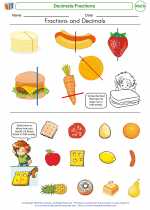 Decimals/Fractions
Decimals/Fractions  Worksheet/Answer key
Worksheet/Answer key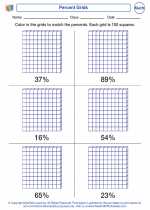 Percent Grids
Percent Grids  Vocabulary/Answer key
Vocabulary/Answer key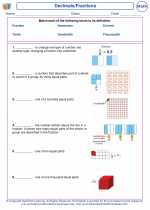 Decimals/Fractions
Decimals/Fractions 

 Activity Lesson
Activity Lesson
 Activity Lesson
Activity Lesson
 Activity Lesson
Activity Lesson
 Worksheet/Answer key
Worksheet/Answer key
 Worksheet/Answer key
Worksheet/Answer key
 Worksheet/Answer key
Worksheet/Answer key
 Worksheet/Answer key
Worksheet/Answer key
 Worksheet/Answer key
Worksheet/Answer key
 Vocabulary/Answer key
Vocabulary/Answer key

Create And Print more Fractions worksheets with Comparing Fractions, Equivalent Fractions, and Simplifying Fractions
The resources above cover the following skills:
Number and Operations (NCTM)
Understand numbers, ways of representing numbers, relationships among numbers, and number systems.
Develop understanding of fractions as parts of unit wholes, as parts of a collection, as locations on number lines, and as divisions of whole numbers.
Recognize and generate equivalent forms of commonly used fractions, decimals, and percents.
Algebra (NCTM)
Use mathematical models to represent and understand quantitative relationships.
Model problem situations with objects and use representations such as graphs, tables, and equations to draw conclusions.
Grade 4 Curriculum Focal Points (NCTM)
Number and Operations: Developing an understanding of decimals, including the connections between fractions and decimals
Students understand decimal notation as an extension of the base-ten system of writing whole numbers that is useful for representing more numbers, including numbers between 0 and 1, between 1 and 2, and so on. Students relate their understanding of fractions to reading and writing decimals that are greater than or less than 1, identifying equivalent decimals, comparing and ordering decimals, and estimating decimal or fractional amounts in problem solving. They connect equivalent fractions and decimals by comparing models to symbols and locating equivalent symbols on the number line.